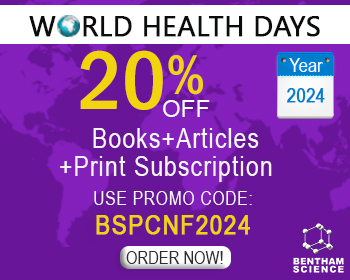[2]
I. C. A. 2018. (Edu.-I.T.A.A.a.c.t.GKToday), 2018. [3] W. H. O. Global tuberculosis report 2016. (Accessed at..
[4]
Zumla, A.; Nahid, P.; Cole, S.T. Advances in the development of new tuberculosis drugs and treatment regimens. Nat. Rev. Drug Discov., 2013, 12(5), 388-404. [http://dx.doi.org/10.1038/nrd4001]. [PMID: 23629506].
[5]
Cohen, J. Infectious disease. Approval of novel TB drug celebrated-With restraint. Science, 2013, 339(6116), 130. [http://dx.doi.org/10.1126/science.339.6116.130]. [PMID: 23307714].
[6]
Salomon, C.E.; Schmidt, L.E. Natural products as leads for tuberculosis drug development. Curr. Top. Med. Chem., 2012, 12(7), 735-765. [http://dx.doi.org/10.2174/156802612799984526]. [PMID: 22283816].
[7]
Nguta, J.M.; Appiah-Opong, R.; Nyarko, A.K.; Yeboah-Manu, D.; Addo, P.G. Current perspectives in drug discovery against tuberculosis from natural products. Int. J. Mycobacteriol., 2015, 4(3), 165-183. [http://dx.doi.org/10.1016/j.ijmyco.2015.05.004]. [PMID: 27649863].
[8]
Haynes, R.K.; Pai, H.H-O.; Voerste, A. Tetrahedron Lett., 1999, 40, 4715-4718. [http://dx.doi.org/10.1016/S0040-4039(99)00830-8].
[9]
O’Neill, P.M.; Posner, G.H. A medicinal chemistry perspective on artemisinin and related endoperoxides. J. Med. Chem., 2004, 47(12), 2945-2964. [http://dx.doi.org/10.1021/jm030571c]. [PMID: 15163175].
[10]
White, J.W.; Nosten, F. Artemisinin-based combination treatment of falciparum malaria In; American Society of Tropical Medicine and Hygiene, 2017.
[11]
Atta-ur-Rahman. Bioactive natural Products (Part C); Elsevier: USA, 2000, Vol. 22, p. 826.
[12]
Zhao, K.C.; Song, Z.Y. Yao, X.X.B. Acta Pharmaceutica Sinica., 1990, 25, 147. [PMID: 2239323].
[13]
Woerdenbag, H.J.; Moskal, T.A.; Pras, N.; Malingré, T.M.; el-Feraly, F.S.; Kampinga, H.H.; Konings, A.W.T. Cytotoxicity of artemisinin-related endoperoxides to Ehrlich ascites tumor cells. J. Nat. Prod., 1993, 56(6), 849-856. [http://dx.doi.org/10.1021/ np50096a007]. [PMID: 8350087].
[14]
Efferth, T.; Dunstan, H.; Sauerbrey, A.; Miyachi, H.; Chitambar, C.R. The anti-malarial artesunate is also active against cancer. Int. J. Oncol., 2001, 18(4), 767-773. [http://dx.doi.org/10.3892/ijo.18. 4.767]. [PMID: 11251172].
[15]
Efferth, T.; Olbrich, A.; Bauer, R. mRNA expression profiles for the response of human tumor cell lines to the antimalarial drugs artesunate, arteether, and artemether. Biochem. Pharmacol., 2002, 64(4), 617-623. [http://dx.doi.org/10.1016/S0006-2952(02)01221-2]. [PMID: 12167480].
[16]
Sadava, D.; Phillips, T.; Lin, C.; Kane, S.E. Transferrin overcomes drug resistance to artemisinin in human small-cell lung carcinoma cells. Cancer Lett., 2002, 179(2), 151-156. [http://dx.doi.org/ 10.1016/S0304-3835(02)00005-8]. [PMID: 11888669].
[17]
Singh, N.P.; Lai, H.C. Artemisinin induces apoptosis in human cancer cells. Anticancer Res., 2004, 24(4), 2277-2280. [PMID: 15330172].
[18]
Singh, N.P.; Lai, H. Selective toxicity of dihydroartemisinin and holotransferrin toward human breast cancer cells. Life Sci., 2001, 70(1), 49-56. [http://dx.doi.org/10.1016/S0024-3205(01)01372-8]. [PMID: 11764006].
[19]
Lai, H.; Sasaki, T.; Singh, N.P. Informa Healthcare; England, 2005, Vol. 9, pp. 995-1007.
[20]
Lai, H.; Singh, N.P. Oral artemisinin prevents and delays the development of 7,12-dimethylbenz[a]anthracene (DMBA)-induced breast cancer in the rat. Cancer Lett., 2006, 231(1), 43-48. [http://dx.doi.org/10.1016/j.canlet.2005.01.019]. [PMID: 16356830].
[21]
Utoh-Nedos, A.U.; Akah, P.A.; Okoye, T.C.; Okoli, C.O. Am. J. Pharmacol. Toxicol., 2009, 4, 169-173. [http://dx.doi.org/ 10.3844/ajptsp.2009.169.173].
[22]
Kalani, K.; Agarwal, J.; Alam, S.; Khan, F.; Pal, A.; Srivastava, S.K. In silico and in vivo anti-malarial studies of 18β glycyrrhetinic acid from Glycyrrhiza glabra. PLoS One, 2013, 8(9)e74761 [http://dx.doi.org/10.1371/journal.pone.0074761]. [PMID: 24086367].
[23]
Kumar, S.; Gupta, S.K.; Singh, D.; Gupta, M.M.; Jain, D.C.; Khanuja, S.P.S.; Kahol, A.P. 2002.
[24]
Bhattacharya, A.K.; Pathak, A.K.; Sharma, R.P. Synthesis of artemisinin derived glycoconjugates inspired by click chemistry. New J. Chem., 2019, 43, 4017-4021. [http://dx.doi.org/10.1016/ j.mencom. 2007.01.011].
[25]
Gupta, S.; Kalani, K.; Saxena, M.; Srivastava, S.K.; Agrawal, S.K.; Suri, N.; Saxena, A.K. Cytotoxic evaluation of semisynthetic ester and amide derivatives of oleanolic acid. Nat. Prod. Commun., 2010, 5(10), 1567-1570. [http://dx.doi.org/10.1177/ 1934578X1000 501010]. [PMID: 21121249].
[26]
Kenneth McClatchy, J. Laboratory Medicine., 1978, Vol. 9, 47-52. [http://dx.doi.org/10.1093/labmed/9.3.47].
[27]
Reddy, V.M.; Einck, L.; Andries, K.; Nacy, C.A. In vitro interactions between new antitubercular drug candidates SQ109 and TMC207. Antimicrob. Agents Chemother., 2010, 54(7), 2840-2846. [http://dx.doi.org/10.1128/AAC.01601-09]. [PMID: 20385864].
[28]
Odds, F.C. Synergy, antagonism, and what the chequerboard puts between them. J. Antimicrob. Chemother., 2003, 52(1), 1-1. [http://dx.doi.org/10.1093/jac/dkg301]. [PMID: 12805255].
[29]
Mdluli, K.; Kaneko, T.; Upton, A. The tuberculosis drug discovery and development pipeline and emerging drug targets. Cold Spring Harb. Perspect. Med., 2015, 5pii: a021154



























